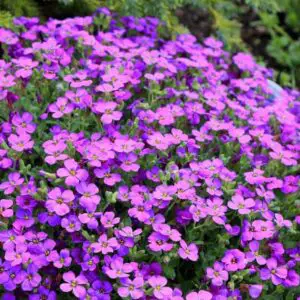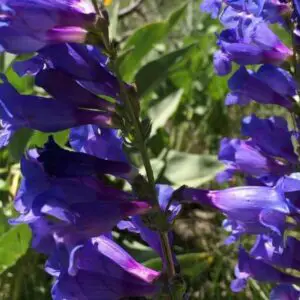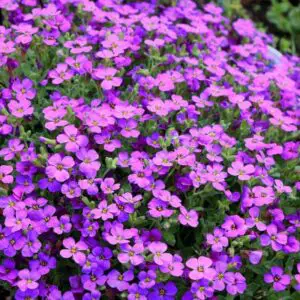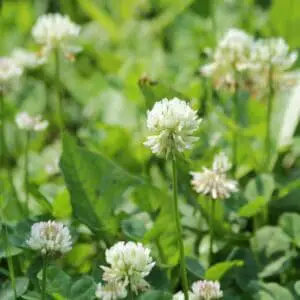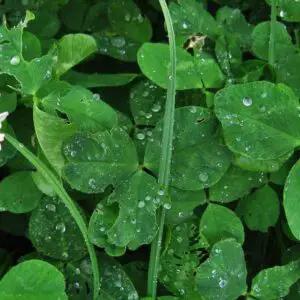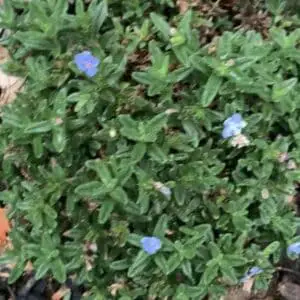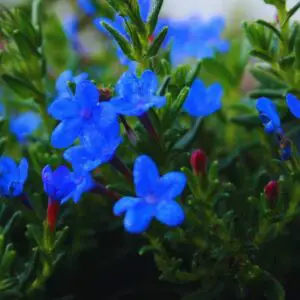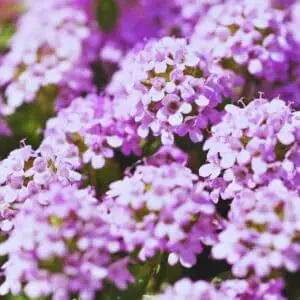Rock cress and creeping thyme are both low-growing, creeper plants. Both plants are great as edging plants or ground cover. Rock cress and creeping thyme produce colorful flowers throughout spring and summer.
Please continue reading for the complete comparison of rock cress vs creeping thyme. I will explain all the differences and similarities between these two plants.

Table of Contents
Also read: Creeping thyme vs creeping phlox
Rock Cress vs Creeping Thyme: Comparison
| Rock Cress | Creeping Thyme | |
| Botanical name | Aubrieta spp. | Thymus serpyllum. |
| Common names | Rock cress False rock cress Aubrieta | Creeping thyme |
| Native area | Europe | Europe |
| Plant type | Perennial, herbaceous | Perennial, herbaceous |
| Plant family | Brassicaceae | Lamiaceae (Mint family) |
| USDA Zone | 4 – 9 | 2 – 9 |
| Bloom time | Spring | Summer |
| Sun | Full or partial sun | Full sun |
| Soil | Well-draining soil | Well-draining soil |
| Soil PH | Acidic Alkaline | Neutral Alkaline |
| Toxicity | Non-toxic | Non-toxic |

Is creeping thyme the same as rock cress?
No. Creeping thyme and rock cress are two different plants. They belong to two different plant families.
What is the main difference between rock cress and creeping thyme?
The main difference between rock cress and creeping thyme is the smell and the flowers. All thyme species including creeping thyme have a pleasant thymy aroma. Rock cress also smells quite good, but not like creeping thyme. The fragrance of rock cress is more noticeable on warm spring days.
Rock cress flowers are a little bigger than creeping thyme flowers. Also, the creeping thyme flower blooms in clumps of flowers, unlike rock cress.


Native area
False rock cress is native to southern Europe and central Asia. It is a common plant in gardens in Europe. Creeping thyme is also native to most of Europe as well as North Africa.
Both these plants have been introduced to other parts of the world such as the United States, Australia, and New Zealand.
Creeping thyme is more commonly found in North America than rock cress (Aubrieta).
Common names
The rock cress plant referenced here is commonly known as false rock cress or Aubrieta. But there is also another rock cress. It is called Arabis. However, these two are two different plants and not the same.
Creeping thyme has many common names. Breckland thyme, Breckland wild thyme, wild thyme, or elfin thyme are some of them.
Plant type
Rock cress is a low-growing ground cover that grows up to 6 inches tall and about 12 to 24 inches wide. Rock cress is a hardy perennial in most climates.
Creeping thyme is also a low-growing, subshrub creeping perennial that grows about 2 to 6 inches tall and 6 to 18 inches wide. This plant remains evergreen in warmer climates. But it will die back in areas with colder winters.
Flowers
Both plants produce colorful flowers. Rock cress has pink, purple, or white flowers. They start blooming in spring. The flowers are small and have four petals.
Creeping thyme also produces beautiful flowers. They also come in the same colors just like rock cress and usually start blooming in late spring and early summer.


Growing conditions
Sun
Both plants require full sun to thrive. But they will survive under partial shade. If they don’t get enough sunlight, they will start to lose their compactness and become leggy. Also, they won’t produce many flowers.
Creeping thyme and rock cress should get at least a few hours of direct sunlight. So, don’t plant them under large trees or other shady areas.
Soil
Rock cress prefers slightly alkaline (PH level between 6.5 and 7.5) rocky soil. You can make the soil more alkaline by adding lime to the soil. Having rich soil is not necessary. However, if the soil is really poor, add a handful of compost before planting.
Creeping thyme grows well in PH-neutral soil with some organic matter like compost. It also does really well on rocky terrains.
The most important thing in the soil to look out for when growing rock cress or creeping thyme is drainage. The soil should be well draining and should not stay wet. This is extremely important since wet and soggy soil can kill the plants. To increase the drainage, you can mix in perlite or sand to the soil.
Alternatively, you can use containers filled with well-draining potting mix.
Water
Both plants require consistently moist soil to thrive. However, the soil should not retain water too much. To avoid wet and soggy soil, water only when the top inch or so of soil is dry.
You will need to water more often in hot weather. Do not let the either of plants go dry for too long.
Temperature and humidity
Rock cress prefers cool temperatures, especially in summer. It doesn’t do well in extremely high temperatures. However, it can grow in high humidity.
Creeping thyme on the other hand can withstand higher temperatures but humidity. It doesn’t like highly humid areas. The plant can lose its leaves in such environments.
It is best to check for specific needs before planting since there are so many creeping thyme varieties.

Propagation
Rock cress
Rock cress can be propagated by either seed or by division.
Dig up the plant using a shovel and cut and separate them into single plants. Then replant in pots or in the ground (about 12 inches apart).
Propagation by seeds is also a great way to get a lot of plants. Remember, the seeds collected from hybrids won’t give you the exact plant. So, it is recommended to buy seeds from a seed company.
Buy Best Rock Cress Seeds
- QUALITY – All seeds packaged by Seed Needs are intended for the current and the following growing…
- Feature. Aubrieta is a small herbaceous perennial forming carpets of green spoon-shaped to…
- [NUMBER OF SEEDS] – The waterproof package of seeds includes 100 seeds
To propagate from seeds, please follow the instructions.
- Sow rock cress (aubrieta) seeds on a sterile potting or seed starter mix. I recommend you use a seed starter kit to increase the germination rate.
- Seeds need light to germinate. So, don’t cover them up.
- Keep the soil moist. Spray with water without disturbing the seeds.
- The temperature should be between 65 to 75 degrees Fahrenheit.
- The seeds will germinate within 2 to 3 weeks.
- EASIER SEED STARTING: Our Burpee SuperSeed tray with 36 flexible pop-out cells is designed to simplify indoor seed starting for all your favorite vegetables, flowers and herbs. Just add seed starting mix, seeds, water and light to get growing! Rows are labeled alphanumerically for seedling identification with included Plant-o-Gram diagram. Tray dimensions: 11.5″ x 10-3/8″ x 2-1/4″
- SMARTER WATERING SYSTEM: Molded corner slots in each cell improve drainage and soil aeration to set your seeds up for germination success. Deep channels in the watering tray draw excess away from the cells, while the raised perimeter edge keeps water contained in the tray – no spills! Seed tray side handles make it easy to lift and pour off excess water or check seedlings daily.
Creeping thyme
Creeping thyme can be propagated by seed, division, or by stem cuttings. Propagating creeping thyme can be done using seed or division just like rock cress.
If you are going with stem cuttings, make sure to use a sterile knife or scissors. Then apply a rooting hormone to the cuts. Then plant the stem in a pot with a well-draining potting mix. Water regularly and keep under partial shade. The stem should start to root and produce small leaves.
Pests and diseases
Rock cress
Rock cress that is growing in wet areas can be suspect to downy mildew. This is a fungal disease. To avoid this disease, plant rock cress in well-draining soil that gets plenty of sunlight. Spacing is also important since good air circulation can prevent many fungal diseases.
Root rot can also be a problem in poor-draining soil. Use soil with mixed perlite or sand to increase drainage.
Creeping thyme
Creeping thyme is also susceptible to root rot. Just use good soil to increase drainage.
Spider mites and aphides (especially in indoor plants) can attack creeping thyme despite its strong scent. You can spray them with a splash of water or use an organic pesticide to get rid of them.
Toxicity
Both rock cress and creeping thyme are non-toxic to humans, dogs, cats, and other pets. They are safe to plant in your garden.
Frequently Asked Questions (FAQs)
What is the common name for rock cress?
Rock cress is commonly known as Aubrieta or false rock cress.
Is Aubrieta deltoidea edible?
Aubrieta deltoidea is an edible plant. Both the leaves and the flowers are edible.
Is cress poisonous?
Cress is considered non-poisonous and safe for humans and pets.
Last update on 2024-05-16 / Affiliate links / Images from Amazon Product Advertising API




